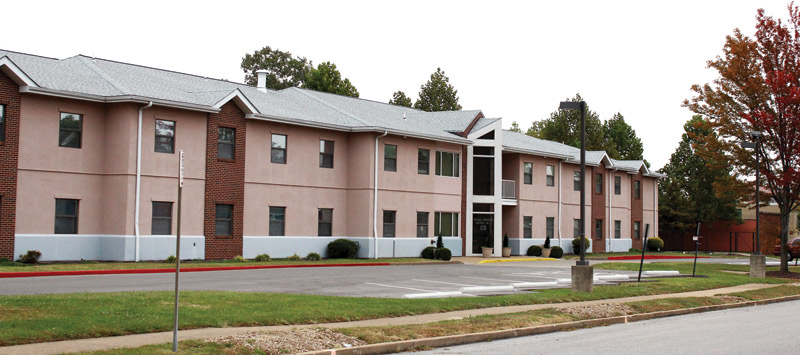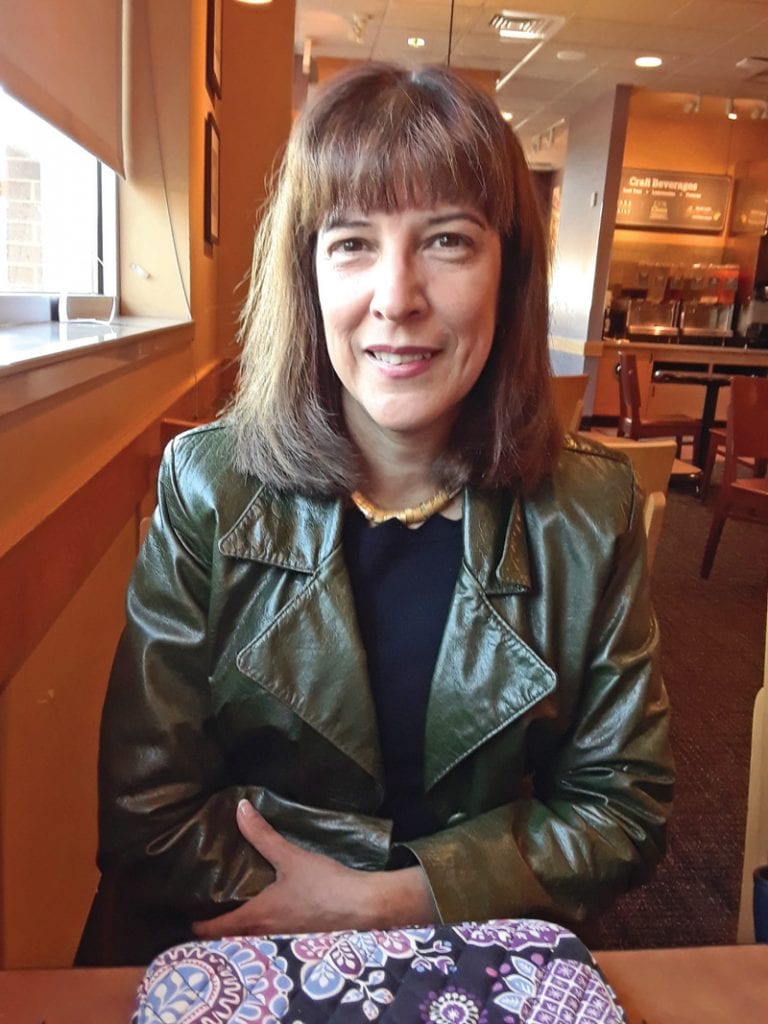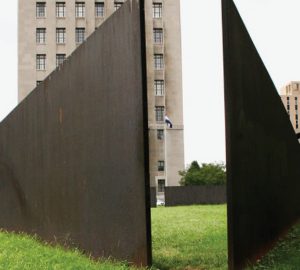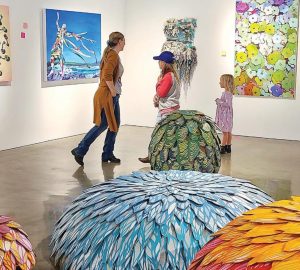union station
Who wants to drive almost into Franklin County to ride a Ferris wheel, unless they need to stock up on fireworks, too? Instead, just head east to the rapidly evolving family entertainment complex that is Union Station. The recently opened St. Louis Wheel towers about 200 feet above the lake, new carousel and scrumpdillyicious soda fountain, and the view is nearly as impressive as it is from 430 feet higher at the top of the Gateway Arch. The gondolas are climate-controlled, and I only waited 5 minutes to climb aboard on a cool, overcast Friday. Toasty inside, my gondola made three smooth and gentle rotations, stopping several times for those needing 100 photos to show anyone willing to look. If you work downtown, you’ve likely seen the Wheel on your commutes to and from the office. Its spokes are illuminated with color-changing LEDs; it’s a unique ride. Unless you’re acrophobic, of course, being high above the Earth is awesome most anywhere. OK, then. There will be sharks. No worries though. They’ll swim lazily among the 13,000 or so other fish in a 120,000-square-foot, two-story, 1-million-gallon aquarium set to open sometime later this year. (Wowsers, we say! And well said, we agree.) The $185 million reinvention of the 1894-vintage station is already wildly imaginative and fun, even without an aquarium in the metro to rival Shedd in Chicago.
ballwin
Another stupid crime, another life-changing injury. Recently, a suspected shoplifter fleeing Menards struck employee Michelle Arthur, 49, with a car. Arthur was hospitalized in critical condition with a head injury. Michael Flamion, a Ballwin cop shot during a July 2016 traffic stop, uses a wheelchair he controls with his mouth. C. Stanton Coats, 63, was semi-retired, clerking part time at a state-controlled North Carolina liquor store in 1968 when two robbers burst in, demanding money. One shot him, paralyzing him from the chest down. He went to Craig Rehabilitation Center near Denver to learn how to live despite his diminished physical capacity. Arthur, Flamion and Coats have Craig Hospital in common. I don’t know Arthur; I’ve met Flamion once. He seemed grateful for the support of his family, his colleagues and the community. Coats was my beloved grandfather. My mother said her dad never expressed bitterness during the remaining 20 years of his life. He kept his feelings to himself—even after the convicted criminals walked out of prison. Grandpa never walked again. Flamion, who also has no use of his arms, may not either. I don’t know about Arthur, but her firefighter husband suspects rehab will be long and difficult. Other than reading about a litany of criminal charges and a $250,000 bond, I have heard nothing about the driver who hit her. But the punishment rarely fits the crime, especially when you hear about the trauma caused for these two people hurt in Ballwin. Usually, criminals couldn’t care less about the permanent damage they have caused, both physical and emotional. Community service should be included in any sentence. In these cases, I think felons also should spend at least a month in a wheelchair.

cwe
By 2045, the metro’s percentage of people 65 or older is projected to rise from 14.9 percent to 25 percent. Mary Ryder Home, founded in 1930 by St. Louisans who witnessed first-hand the Great Depression’s devastation—especially for women who were abandoned, homeless and without support—has expanded its reach by joining Provident Behavioral Health. Leadership teams and boards will be combined, and all employees will be retained. Located in the CWE, Mary Ryder is home to 65 St. Louis senior women, offering them safety and support while meeting their mental and physical needs. From bereavement to financial changes to loss of mental and physical function, this population especially can benefit from behavioral health care. In addition, Provident manages feelingkindablue.org, a peer-to-peer social networking site.
u. city
The last day of a streetcar system operating in and around the StL was May 21, 1966. So, were vintage streetcars—the Loop Trolley, which debuted 11 months ago and is expected to hit the end of the line next month—an anachronism? It was a well-intentioned project from the start for those who rallied behind Joe Edwards, tireless business and civic leader behind so many redevelopment projects in the Delmar Loop, who had envisioned such a project for more than 20 years. But almost everything about the new line, which received a $25 million federal grant in the early years of this decade, went off the rails. An early route along Olive Boulevard from the CWE to downtown never came to fruition. Big donors kicked in, as did the county: the latter, $3 million. Construction started late. Delays. More delays. The ultimate cost? Some $51 million. The long-awaited, much-ballyhooed maiden voyage was postponed from Nov. 15, 2018, to Nov. 16 because of a heavy, early snow. Not a good omen. The route—from the west end of the Loop to the history museum in Forest Park—only made sense, in my amateur analysis, for tourists. Your faithful scribe lives with his wife and dog in the west end of town near I-170 and Delmar. So why didn’t it start there, we asked ourselves? Shouldn’t it at least have gone deeper into the park, or even the CWE, others asked? Many questions, few answers. Ridership didn’t meet expectations; fare revenue lagged behind projections. Trolley management says $200,000 is needed to survive until November, a half-million more to make it to 2020. Although the County Council has stated flatly that it would cough up no more funding, the City of St. Louis has yet to weigh in. Eventually, could the three beautifully restored trolleys be transported (by truck? Train?) to the National Museum of Transportion on Barrett Station Road? Or, could they become the first exhibit in a new museum called the U.S. Boondoggle Bunker at the Loop Trolley headquarters building? There might be room for all three underutilized streetcars, an Edsel or two, and maybe even the ill-fated Spruce Goose, an immense, ungainly wooden seaplane designed and built by Howard Hughes. It got into the air only once, and that might have been by accident.

notable neighbors
wildwood
Mauricio Gobbo’s company transferred him in 2008 from Brazil to Connecticut for what he and his wife, Susan Gobbo, thought would be a short-term assignment. What started as a grand adventure in paradise, with jaunts to New England, Philadelphia, Boston and New York, was but a honeymoon. His assignment became permanent—in St. Louis. Susan, whose career in a São Paulo hospital was as a physical therapist in the ICU caring for cardiac and pulmonary patients, soon found that she had become ‘less than.’ “There, I was Dr. Susan,” she says. “Here, I was Mauricio’s wife and Laura’s mom.” (Since inquiring minds want to know, Laura, 18, graduated from Eureka High School, answers Susan, chuckling at the question.) Although Susan was studying English, people were condescending because of her accent. Her family and friends in Brazil didn’t understand, saying she had to be living a queen’s life. But many spouses who don’t integrate well end up returning to their countries, some leaving their partners as well. As her loneliness and frustration mounted at home in Wildwood, she started research that showed she was not alone: Like many professional ‘trailing spouses,’ she was depressed. When you’re in the middle of it, you don’t realize it. “I saw the problem, and I set out to solve it,” she says. She contacted the St. Louis Mosaic Project at the World Trade Center here in 2014. Accomplished and gregarious, she soon co-founded a meetup group for international spouses, among them physicians, lawyers and businesswomen in their countries of origin. They do everything from visit the botanical garden and art museum to learn how to serve on boards. There are more than 400 members. Susan also works side by side with ‘hometown girl’ Annie Schlafly, who founded a mentoring program for international women in 2017. This program also helps acclimate foreign-born professional women to the country and introduce them to corporate entities, not to mention familiarize them with the the Lou’s wonderful peculiarities (i.e., the requisite high school inquiry). At present, 17 groups are in force, each comprising five St. Louis mentors and an equal number of international women. There are five yearly group meetings, six one-on-one. On Oct. 15, 100 women enjoyed a girls’ night out at STL Foodworks. Other activities include yoga, an international book club, and Blues (yay!) and Cardinals (dang!) games. “We are from different parts of the world, but when we’re together, we speak the same language,” Susan says.








